Reviews
Ani Imoto
Mikio Naruse
Japan, 1953
Credits
Review by Ian Johnston
Posted on 28 November 2007
Source VHS
Categories Flowing: The Films of Mikio Naruse
Naruse is in essence an urban director and Older Brother, Younger Sister is one of his rare films with an exclusively rural setting. Indeed, the point is made about how close Tokyo is, yet we never get a glimpse of the city, even though San and Mon, the daughters of the family at the centre of the story, both live there. Instead, the river, which Naruse constantly returns to as a linking device between sequences, forms a barrier beyond which we never go, just like the majority of the traditionally-minded inhabitants of this rural community.
Older Brother, Younger Sister is also further confirmation—if you should need it by now—of how great a director Naruse is. Here’s a little-known work that turns out to be simply superb, an almost perfect illustration of Kurosawa’s famous formulation of the director’s style as “a flow of shots that looks calm and ordinary at first glance, [but] reveals itself to be like a deep river with a quiet surface disguising a fast-raging current underneath.” Appropriately enough, the first shot of the film (under the credits) is of river water flowing over stones, and then the following opening sequence sketches with a whole series of visual links (stones, water) the connections - they turn out to be family ones - between a number of characters. First, there’s father Akaza, despondently wandering the riverbank (when he isn’t getting drunk in a bar) since the loss of both his earthmoving business and his own sense of self-esteem. His wife Riki, for her part, supports a family fallen on hard times by tending a small snack shop slightly out of town. Younger sister San is a student nurse, and it’s her return home that structures the film’s three-part narrative. And elder sister Mon has left home early to support the rest of the family, and now has returned, pregnant and unmarried.
The one family missing here is the older brother of the title, Inokichi, a rough and shiftless young man who is hanging about the streets of their small rural town because of his refusal to meet his “fallen” sister. We might guess here that his anger and disgust are moral, fuelled by a sense of social shame, but later scenes will reveal that there’s a lot more to it than that. In any case, by this early scene we have already learnt of Inokichi’s unreliability and disinclination to keep a job when we observe his father slapping him in the street in outrage at his bad habits (frequenting prostitutes, playing pachinko).
The title Older Brother, Younger Sister is not entirely accurate. Japanese has no plurals, and no doubt the original Japanese Imoto is meant to refer to both sisters, San and Mon, who, although Inokichi provides the most dramatic scenes in the film, are really at the core of the story. Inokichi’s violence and consequently his role are important to the narrative, but it has to be said that Masayuki Mori’s performance is the least satisfactory aspect of Older Brother, Younger Sister. Mori, of course, is great as Floating Clouds’ Tomioka, the self-centred, increasingly seedy, and unworthy object of Yukiko’s love, but here his performance seems too calculated and played on the surface, nowhere as convincing as the other perfectly-cast roles of the film.
Inokichi is coarse, brutal, and violent. His rough insensitivity is even expressed in the way he drinks water from the courtyard well, which Naruse deliberately contrasts with an earlier scene of Mon doing the same, and then soon follows it up with a shot of a courtyard bush trembling from the impact of the half-eaten piece of fruit Inokichi throws into it. Inokichi’s brutishness and insults drive Mon away, with her promising both never to return and to keep her child. She’s actually more affected emotionally by the situation than at first appears. Naruse first emphasises her languorous physicality, highlighted by Machiko Kyo’s lush beauty and the luxuriant way she stretches out on the floor. But this whole first section of the film ends when, after defiantly leaving the family home, she crouches down in despair, and the film fades out on her weeping.
From this point, Inokichi ratchets up the violence. In the second part of the film, introduced by another shot of the river, this time of the water lapping at rocks on the riverbank, Mon’s student boyfriend, the father of her child (who, in the time that has passed, has been born stillborn), pays a visit. This very formal meeting is magnificently staged by Naruse, where the interchange of looks through successive medium shots of one character conveys the father’s suppressed anger, the mother’s feelings of upset, and the student’s embarrassment. Once the student is on his way, he’s now tracked by a vengeful Inokichi. Naruse’s tracking camera - pursuing the student, receding before Inokichi’s advance - builds up the tension before their confrontation, which works to reveal Inokichi’s deep feelings for his sister, feelings which verge on the incestuous. (There’s a curious but very affecting interruption to this scene with a sudden cut away to a shot of the rapidly flowing river, and then a shot of Azaka staring at this river, the symbol of the remnants of his former life.)
Now through Inokichi’s own words we learn of the basis for his feelings of closeness to Mon, of how as young children they shared the same bed, of how he would guide her to the toilet in the middle of the night, of how - as he puts it - before she turned seventeen, not a day would pass when he didn’t eat with her, didn’t see her face. And it seems as much the student’s concession that he might marry Mon, rather than his seduction and impregnation of her, that makes Inokichi explode, striking the student and kicking him on the ground. In a sign that the student’s actions are not the issue here - rather, it’s Inokichi’s feelings for Mon—Inokichi quickly gives up on his assault on the student, even rather comically pointing him in the right direction of the bus stop.
Even greater violence is reserved for Mon herself in the last section of the film. This scene, with its raw emotion and physicality, is the climax of Older Brother, Younger Sister, and it’s unlike anything I’ve seen in any other Naruse film. Mon returns home now, if anything asserting her status of “fallen woman” as she walks the country path to the house, dressed in a good kimono, parasol held high, crunching a popsicle and acknowledging the calls from a truckload of passing labourers. At home she speaks authoritatively if derisively of men although the precise nature of her work in (we presume) the sex industry is left unclear. The atmosphere is thick with the tension between her and her brother when, after he boasts of the beating he gave the student she explodes, laying claim to her right to do what she wants with her body (“My body was mine to give to him”) and overturning a table in her anger.
Inokichi responds by repeatedly slapping her to the increasing horror of his mother and San. Mon is steadfast and resistant to Inokichi, and a challenge to him as well. When his slaps push her out into the courtyard, she refuses to fall, holding herself upright, and she dares him to strike her—which he does. This scene reaches its peak of emotion with the single shot of the mother screaming for them to stop and falling to her knees. This does nothing to stop Inokichi, and San can do nothing but sink to her knees with her face in her hands. The searing viscerality of this scene ebbs into one of emotional devastation when Inokichi storms out, emphasised by the compositional qualities that Naruse leaves us with, the empty foreground space and the separate space between each of the three women.
Inevitably we focus on the characters of Mon and Inokichi and their violent confrontation, but in actual fact the brother ultimately has a less central role to play than his two younger sisters, and although the subtlety of this finely-wrought film never overplays the fact, it is the younger of the two sisters, San, who is our guide through the tangled emotional setup. Older Brother, Younger Sister is structured around San’s three visits home, each of which coincides with an aspect of Mon’s story: her pregnancy, the visit of her student lover, her fight with Inokichi. But San has her own story as well. She has a local boyfriend, Taichi, who has been adopted by a conservative couple who lost their own son in the war and who disapprove of any connection with San and what they regard as her disreputable family.
San is a very different young woman from her sister Mon. She’s quiet and modest, demure as we can see in the way she lowers and raises her eyes when first told about Mon’s pregnancy by her mother, and in the progress of the film she’s going to experience emotional heartbreak, although Naruse plays this strand of the story very quietly and subtly. Taichi is going to disappoint her—in spite of his willingness to run away with her to Tokyo (which San herself refuses to countenance, wanting him to be honest and forthright about his feelings for her to his adopted parents) Taichi is going to accept his arranged marriage. On her third visit home it seems as if San has an inkling of this in the way she avoids passing Taichi’s family home in town, instead approaching her own home along a roundabout route. This has the rather bizarre effect whereby San and Mon meet at intersecting country roads, both on their way home. (There’s an added bizarre touch in that the two sisters both live in Tokyo but would appear to have no contact with one another there. It’s only when they return to the countryside that they meet up again. It’s another way that the Tokyo that remains unseen to us has no true weight or presence for any character in this film. It remains simply as an intangible negative image of the world of the film, a place of refuge for those like San and Mon who want to escape.) The devastating scene between brother and sister that San is witness to finds an almost sublime release in the following sequence. San and her mother join other townspeople at night to place lighted lanterns on the water and watch them float away. This presumably is Toro Nagashi, the Festival of Floating Lanterns, where the souls of the departed are symbolically sent on their way. So, her mother kneels to pray and San sets her lantern off on the water, although the sense of release is not complete for San, disconcerted as she is when the camera follows the lantern to pass closely by Taichi and his new bride sitting on the riverbank.
There’s now a quite remarkable pairing of shots. First, in a very resonant shot Taichi slowly rises into an empty frame to stare at San in a look of yearning and regret. This is then answered by a shot of San waving goodbye, but in full daylight the next day. Diegetically, San is along with Mon saying goodbye to her mother, but this shot is also a symbolic farewell to Taichi, a sign that San will get over the emotional pain he has brought her. It’s also a symbolic farewell on the part of both San and Mon to the countryside that is the exclusive setting of Older Brother, Younger Sister. The older brother Inokichi, whose blustering and violence attract more of our attention than is really deserved, is literally out of the picture, and Mon now seems as at ease with him as San is with Taichi when she says that she will come back to see both her mother and her brother. Observed from separate locations by their mother and father, the two sisters walk off down the country road under a single parasol. We’re told nothing of what the future may hold for them—apart from a shared disdain for men—but we can be sure that both, in their very different ways and in a quintessentially open Naruse ending, have the strength to persevere.
More Flowing: The Films of Mikio Naruse
-
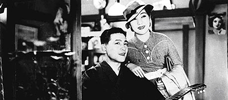
Wife! Be Like a Rose!
1935 -
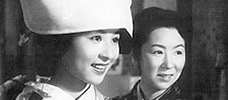
Mother
1952 -
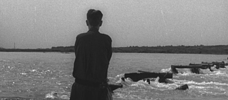
Older Brother, Younger Sister
1953 -

The Sound of the Mountain
1954 -

Floating Clouds
1955 -
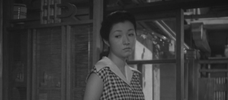
Flowing
1956 -

Summer Clouds
1958 -
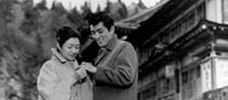
Yearning
1964 -
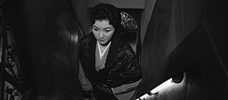
When a Woman Ascends the Stairs
1960 -

Repast
1951
We don’t do comments anymore, but you may contact us here or find us on Twitter or Facebook.



